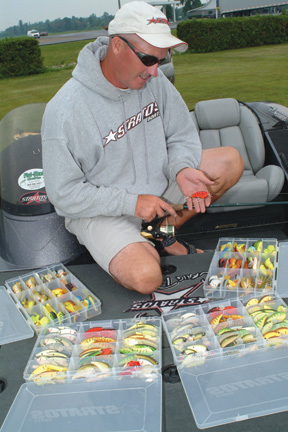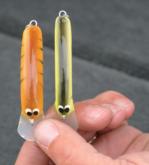Tournament Tested: Homemade crankbaits

Wal-Mart FLW Tour pro Craig Powers of Rockwood, Tenn., has a strange way of showing his love for crankbaits. It is perfectly normal for him to buy a dozen “store-bought” crankbaits, only to rip them apart and rebuild them to his own specifications.
After years of sawing, sanding, gluing and painting thousands of crankbaits, Powers arrived at one conclusion: When it comes to shallow-running crankbaits, nothing beats homemade.
Lately, the words “homemade” and “handmade” seem to be on the lips of successful bass pros when referring to crankbaits.
For the most part, homemade crankbaits are made for pros by an individual or small lure company. The baits do not often get much publicity because the pros who use them are usually in no hurry to divulge their “secret” bait, and the companies that produce them simply do not have the resources for large-scale promotional efforts.
But Powers, who thrives on handcrafted baits, is willing to break the silence on homemade plugs.
 “When I talk about homemades, I’m talking about wooden crankbaits that are hand-carved and hand-painted and made for shallow cranking – mostly 6 feet or less,” he said. “If I’m deep cranking, like in the summer, I’ll usually use a store-bought plug.”
“When I talk about homemades, I’m talking about wooden crankbaits that are hand-carved and hand-painted and made for shallow cranking – mostly 6 feet or less,” he said. “If I’m deep cranking, like in the summer, I’ll usually use a store-bought plug.”
Powers relies on shallow-diving crankbaits for a majority of his shallow-water fishing because he has a general dislike for spinnerbaits and rattling crankbaits.
“I grew up fishing tournaments on Boone Lake in Tennessee,” he said. “It’s a river impoundment, and nearly all the bass live on the bank. It’s also a heavily pressured lake, and everybody throws spinnerbaits and Rat-L-Traps. I discovered that if I was going to catch bass behind 50 other boats on Boone, I had to find something different to throw.”
And so Powers’ longtime obsession for shallow-running crankbaits began.
“Once I learned how to cast a crankbait to the same places other guys cast spinnerbaits or pitched jigs, I started catching a lot of bass behind them,” he said.
 What he discovered about crankbaits was that he could make them “hover” in the strike zone a lot better than a jig or spinnerbait.
What he discovered about crankbaits was that he could make them “hover” in the strike zone a lot better than a jig or spinnerbait.
“You have to keep a spinnerbait moving, and a jig just goes to the bottom,” he said. “But a crankbait is buoyant – you can twitch it, pause it and make it hover right in the strike zone a second longer, and that makes a tremendous difference, especially in finding fish.
“I’ve noticed that bass show themselves a lot more with a crankbait,” he said. “They might not always commit to it, but they seem more likely to flash on it, and that tells me where they live. Ninety-five percent of this game is finding fish, and crankbaits allow me to cover water quickly to find shallow fish.”
With much experimentation, Powers eventually took a liking to wooden crankbaits because of their silence and ease of customization.
“Most plastic plugs have a built-in rattle, and I don’t like rattles in shallow crankbaits,” he said. “Wood is quieter, and it lends itself to modification much better than plastic.
 “I can take a wooden body and put the bill, line tie and belly weight anywhere I want,” he said. “I might put in 10 different bill designs at 10 different angles and switch the belly weight around several ways before I come up with the right combination. I like being able to tweak the action of plugs – you just can’t do that with a plastic bait where the bill is permanently molded into the body.”
“I can take a wooden body and put the bill, line tie and belly weight anywhere I want,” he said. “I might put in 10 different bill designs at 10 different angles and switch the belly weight around several ways before I come up with the right combination. I like being able to tweak the action of plugs – you just can’t do that with a plastic bait where the bill is permanently molded into the body.”
But the trade-off is that wood is much less durable than plastic. Once a wooden bait dents and water leaks into the wood, it swells, the paint cracks and the bait loses its performance.
“That’s the problem with wood; it just doesn’t hold up,” he said. “If you fish a wooden plug hard, you’re lucky to get a couple of days’ use out of it before the bill breaks or the line tie loosens or the paint begins to chip off.”
Several years ago, Powers teamed up with crankbait designer Sonny McFarland of Lenoir City, Tenn., to produce longer-lasting wooden plugs.
“Sonny has been hand-making plugs for about 27 years,” Powers said. “He has developed a process for making balsa-wood plugs much more durable. Before the baits are painted with any outer coating, he dips them multiple times in a solution to harden the wood. He also makes his bills from circuit board, which withstands the abuse that comes with cranking rock and riprap.”
 The result is McFarland’s Flat-Shad crankbaits, a series of flat-sided balsa-wood crankbaits, which have earned Powers’ stamp of approval.
The result is McFarland’s Flat-Shad crankbaits, a series of flat-sided balsa-wood crankbaits, which have earned Powers’ stamp of approval.
But having a good homemade plug is only half of the equation; the other half is knowing when and where to use it.
Over the years, Powers has perfected his homemade brand of cranking on reservoirs in the southeastern quadrant of the country.
According to Powers, the technique works best in the cold-weather months from November through April, when water temperatures range from 47 to 70 degrees.
“Fall is absolutely the best time for homemades,” he said. “When the water temperature starts dropping and the fish move up on the flats, that’s my favorite time to fish them.”
When cranking shallow flats, Powers uses a Flat-Shad “PT” crankbait, which runs 3 to 5 feet deep. He fishes the bait on a 6 1/2-foot medium-action spinning rod with 10-pound-test line. He reasons that a spinning rod casts the baits farther.
“Speed is the key on the flats,” he said. “I crank it as fast as I can without any pauses. It is a total reaction bite.”
 However, in the spring, as fish start moving toward the bank, Powers switches tactics.
However, in the spring, as fish start moving toward the bank, Powers switches tactics.
“When the water gets around 60 degrees, I’ll move up into any shoreline cover I can find and begin throwing a Sonny `B,’ which is a little fatter and more buoyant.”
He fishes the Sonny “B” on a short 6-foot casting rod and 17-pound-line to make accurate presentations around heavy cover.
“I’ll put that bait anywhere a spinnerbait or jig will go,” he said. “But instead of burning it, I’ll finesse it more – twitch it and pause it to get the fish to react on the bait.”
Once fish start spawning, Powers usually puts his homemades down for while.
“On some lakes, there’s a small period of time right after the spawn when bass will get on the first break in about 3 to 6 feet of water and I’ll use a homemade then, but once they start moving out to the deeper ledges, I’ll switch to a store-bought plug.”
Purchasing homemades
Homemade crankbaits can be hard to find. Mass production of “handmade” plugs is difficult because wood is so temperamental and the manufacturing process is so labor-intensive.
Several lure companies have moved beyond making plugs solely for the pros, and now their homemade balsa-wood baits are available through the Internet.
Be forewarned, though, these baits are expensive. Be prepared to pay upwards of $20 for these exclusive plugs.
Sonny McFarland’s Flat-Shad crankbaits used by Craig Powers can be found at flatshad.com.
FLW Tour pro Rick Clunn of Ava, Mo., a longtime advocate of wooden crankbaits, endorses the Thunder Shad series of crankbaits made by Awesome Bait Company in Eufaula, Ala. (thundershad.com). His favorite models include the “Grandfather,” a fat-bodied balsa bait with a square lip.
Kellogg’s pro Clark Wendlandt of Cedar Park, Texas prefers Brian’s Bees made by Brian Huskins in North Carolina (brianscrankbaits.com). Wendlandt uses the Bee 1, Bee 2 and Bee 3 models.